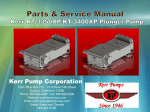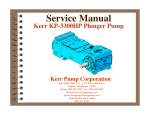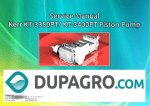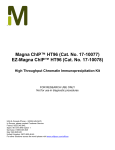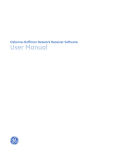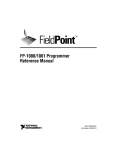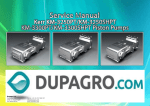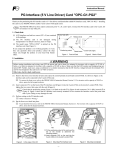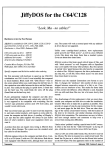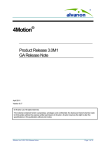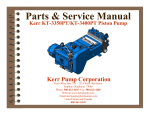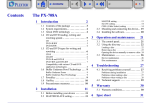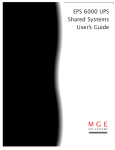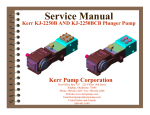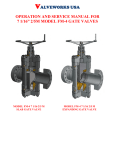Download Service Manual Cover - Nov 06.psd
Transcript
KERR PUMPS SERVICE MANUAL
EIGHTEENTH EDITION
NEW PUMP WARRANTY
1) KERR MACHINE COMPANY (Kerr Pumps) warrants its new pumps to be free from defective materials and/or workmanship
for a period of one year from the date of sale by the Distributor, provided that the new pump is registered in accordance with
Paragraph No. 2 hereof, properly installed and operated in accordance with the Company’s Service Manual, and all other terms
of this warranty agreement are complied with by the purchaser. As hereinafter provided, this warranty includes the
replacement of parts and labor to correct any deficiency. All defective parts must be returned to the Company’s Home Office
for examination before this warranty is effective. This warranty applies to parts, which have been replaced under this warranty
only so long as the original pump warranty is effective. This warranty is for the exclusive benefit of the purchaser and is not
transferable.
2) Each Distributor of a new KERR PUMP, will provide the customer with a registration blank furnished to him by the
Company which must state the date of sale, be signed by the purchaser and the Distributor, and delivered to the Home Office
of the Company within fifteen (15) days of the date of sale.
3) In the event of a claim under this warranty, made within the one-year warranty period, the purchaser must notify the
Distributor, and the Distributor shall contact KERR PUMPS before any repairs or service calls are made.
4) All warranty claims must be sent to Kerr Pumps Home Office on the authorized warranty claim form provided by Kerr
Pumps, and available from the Distributor before any warranty claim will be considered. It is understood that Kerr Pumps
will deteriorate due to ordinary wear, therefore, the following credits shall apply to all replacement parts, labor, surface freight,
travel time and mileage allowance furnished under this warranty.
A. For the first ninety (90) days from the date of sale by the Distributor, 100% credit will be allowed on a current list price
basis.
B. From 91 to 180 days from the date of sale by the Distributor, 75% credit will be allowed on a current list price basis.
C. From 181 days to 270 days by the Distributor, 50% credit will be allowed on a current list price basis.
D. From 271 days to one year after the date of sale by the Distributor, 25% credit will be allowed on a current list price
basis.
The credit given to the Distributor for replacement parts or pumps under this warranty is based upon the Distributor’s net cost
paid Kerr Pumps for such replacement parts or pumps.
-1-
5) In the event of a warranty claim under this warranty made within ninety (90) days of the date of sale by the Distributor, KERR
PUMPS, before any repairs are made, shall be contacted by the Distributor and given the option of having the Distributor
either repair or replace the pump.
6) Upon any claim under this warranty, other than a claim wherein KERR PUMPS at its option replaced the pump as provided in
Paragraph No. 5 hereof, the Distributor will make the necessary repairs an/or replacement, and KERR PUMPS shall allow the
cost of labor on warranty claims. The labor cost may include travel time not to exceed (8) hours of actual travel time. KERR
PUMPS will pay surface freight on warranty shipments. After making the necessary repairs and/or replacements, the
Distributor will bill the customer for the full amount due for the repair. Thereafter, the Distributor will submit the warranty
claim form provided by KERR PUMPS to the KERR PUMPS Home Office for consideration. In the event the warranty
claim is honored by KERR PUMPS a Credit Memorandum will be issued to the Distributor in the amount determined by the
table in Paragraph No. 4 hereof. Thereafter, the customer’s invoice will be credited by the Distributor in the same percentage
allowed the Distributor by KERR PUMPS.
If requested by KERR PUMPS the purchaser or the Distributor shall return the alleged defective product to KERR PUMPS
factory, freight prepaid, for examination and testing. If KERR PUMPS determines the product is defective KERR PUMPS
will either repair or replace such product with a like of KERR PUMPS manufacture, f.o.b. to the Distributor or allow the
Distributor credit to an amount equal to the invoiced value of the defective product. The responsibility of KERR PUMPS is
limited to the repairing or replacing defective material manufactured by it, provided KERR PUMPS examination discloses to
its satisfaction that such material has not been altered or repaired, other than by KERR PUMPS approved procedures, subject
to misuse, improper maintenance, negligence or accident. KERR PUMPS will not be responsible for loss of liquid or for
damage of any kind, or from any cause, to any person or property of any person, or for loss of revenue of profit, or for any
other special incidental or consequential damages.
7) The warranty applies only to new KERR PUMPS. The Company specifically excludes from this warranty the following.
A. All plungers, valves, plunger packing, valve springs, seals gaskets, and corrosion and/or erosion damage caused by the
fluid handled by the Company’s pump.
B. In addition, after the expiration of the pump warranty all replacement parts are no longer in warranty.
8) In extreme cases where in the opinion of KERR PUMPS, if a pump has been misused or is being misused, KERR PUMPS
reserves the option to offer to redeem the pump from the purchaser. Should the purchaser refuse to allow the pump to be
redeemed and chooses to continue improper operation, the warranty will be void.
-2-
9) Any parts or equipment which KERR PUMPS supplies and does not manufacture shall be subject only to the warranties of
KERR PUMPS vendors to the extent KERR PUMPS can enforce such warranties.
10) Any repairs to, alterations of, or work done on alleged defective products without KERR PUMPS specific written
authorization shall void KERR PUMPS warranty applicable thereto.
11) Any action for breach of warranty or other action under this agreement must be commenced within (1) year after such cause of
action arises.
This limited warranty is in lieu of all other warranties, expressed or implied, including any implied warranty or
merchantability or fitness.
-3-
KERR TROUBLE SHOOTER GUIDE
REASON OR SERVICE NEEDED
Unusual pounding, knocking broken valve spring
Loss of pressure or volume
Consistent, rhythmic knock
Packing failure (Excessive)
Abnormal wear of fluid end parts
Abnormal wear of power end parts
Heat in power end
Insufficient fluid at high speed. Check to see if the suction line is
the proper size and is not constricted trash in line, valve partly
opened, etc. There is also a possibility of gas in the fluid causing
the roughness.
Also above. Foreign matter may be holding valves open. Worn
valves. Broken springs.
Improper bearing adjustment. Worn bearings or connecting rods.
NOTE: Valve noise is common and normal in high-speed pumps.
It should not cause concern unless it becomes erratic.
Improper installation. Improper type lubrication.
Incorrect type packing for particular installation.
(Contact Kerr Pumps if in doubt) Excessively worn plungers.
Abrasive or corrosive fluid.
Lack of oil, overload on pump, foreign matter in oil.
A new pump will run hot for a short period (2 or 3 days). Check
above for persistent heating. Pump will operate near 140˚ F.
under average conditions.
Check for air in pump by bleeding at cover caps. Too much
spring tension Reciprocating pumps have very limited pick up,
check installation section.
-4-
INSTALLATION INSTRUCTIONS (SEE ILLUSTRATION)
The importance of proper installation cannot be overstressed. As the reciprocating pump is almost unable to lift fluid, proper
suction flooding is a must. This is the First step toward satisfactory operation.
The Kerr Pumps Engineering Service will be happy to advise you in your installation problems. As almost every installation
varies, you cannot exercise too much care in making certain your installation is proper.
Before Starting The Pump, read carefully the maintenance section in the following pages.
To start the pump, open the suction line valve and permit the intake chamber to fill on the pump. Air may be bled off by
opening the valve covers slightly until there is a constant fluid flow. After bleeding, open the discharge line valve and start the pump.
Roughness may occur from cavitation (air in line) or from starvation (lack of fluid). Eliminate these troubles before permitting
continuous operation.
-5-
RECOMMENDED INSTALLATION OF KERR PUMPS
FOR BEST RESULTS
(A)
(B)
(C)
(D)
(E)
(F)
PRESSURE RELIEF VALVE (REQUIRED)
BY-PASSED FLUID SHOULD BE PIPED BACK IN SUCTION SUPPLY TANK WHEN POSSIBLE
USE FLEXIBLE HOSE IN DISCHARGE LINE WHEN POSSIBLE
DISCHARGE SHUT-OFF VALVE (OPTIONAL-USED FOR TOTAL SHUT-DOWN OR SERVICE ONLY)
DISCHARGE AND SUCTION ON EITHER SIDE OF FLUID END ON ALL MODELS.
PULSATION “DAMPENERS” MAY BE USED IN EITHER THE SUCTION OR DISCHARGE PIPING OR BOTH.
DISCHARGE DAMPENERS SHOULD BE CAPABLE OF HANDLING PUMP DISCHARGE MAXIMUM PRESSURE
AS A GENERAL RULE, FLUID
LEVEL MUST BE HIGHER
THAN THE PUMP FLUID END
AS PLUNGER PUMPS CANNOT
"LIFT” FLUID. ABOUT 10 FEET
OF HEAD IS A GOOD “RULE OF
THUMB”.
SUITABLE
FALL-OPENING
VALVE
CAUTION SHOULD BE TAKEN TO KEEP FITTINGS OUT OF THE SUCTION AND
DISCHARGE PIPING AS THESE WILL RESULT IN POOR PERFORMANCE. EACH
90-DEGREE TURN IN THESE LINES RESULTS IN GREAT LOSS OF PUMPING
EFFICIENCY.
-6-
PREVENTIVE MAINTENANCE
DAILY
1. Check and Maintain Lubricant Levels.
Standard Lubricant:
Synthetic Lubricant:
AGMA Grade (ASTM D 2422): 4 EP
SAE Viscosity Grade (J306-8): 75W-90
ISO Viscosity Grade: 150
Viscosity in SSU @ 100 degree F: 625-765
PUMP CAPACITIES (APPROXIMATE)
KD-1250
2 qts.
KT-3350
16 qts.
KJ-2250
3 qts.
KT-3400
16 qts.
KM-3250
4 qts.
KB-3500
20 qts.
KM-3300
4 qts.
KA-3500 36 qts.
KP-3300
12 qts.
KSB-6400 36 qts.
R335/R340 16 qts.
KSB-6500 36 qts.
Q5450
22.5 gal.
KCP-6300 24 qts.
KZ-3150
2 qts. Use SAE 30 weight non-detergent motor oil
PLANETARY GEAR REDUCERS
#6 AUBURN
17 ozs.
#8 & #9 AUBURN
42 ozs.
2. If pump has lubricating facilities for stuffing boxes, check level of lubricant.
3. Maintain packing gland tension on packing (Do not over-tighten)
4. Visually inspect pump for apparent trouble.
5. Keep the pump clean.
-7-
MONTHLY
1. Drain and refill crankcase. It is recommended that oil be changed after the first week of operation.
2. Wash oil filler cap in kerosene.
3. Check valves for excessive wear, broken or bent springs, etc.
4. Check crankshaft bearings for endplay. (See section on crankshaft)
5. Keep all nuts, studs, etc. tight.
6. Check valve covers for leaks.
7. Check all seals and gaskets for leaks
GENERAL
Replace any work part before its eventual failure. Use the following instructions for removal and replacement of parts. Don’t
hesitate to call on Kerr Pumps for help if necessary.
-8-
SERVICE PROCEDURES (ALL MODELS)
1. VALVES (Wing-guided type):
A. Discharge Valves: The discharge valve and seat can be exposed by first removing the discharge valve cover cap. Once
the discharge cover cap has been removed you may lift out the discharge valve spring and the discharge valve. The
valve seat will be held in place by a taper fit and must be “pulled” with an appropriate valve-pulling tool (available
from the Kerr Pumps Dealers). Once the valve and seat have been removed they should be resurfaced or replaced if
badly worn. To replace the discharge valve, first clean and inspect the seat bore for washout defects and then drop the
seat into the bore. Replace the valve into the seat and strike the top of the valve a couple of good blows utilizing a
brass bar and hammer to seat the valve seat in the fluid end valve bore. Replace the valve spring and cover cap after
inspecting the spring and the seal of the cover cap.
B. Suction Valves: The suction valves are located in the chamber directly below the suction or end valve cover caps. The
suction valves are serviced in the identical manner as the discharge valves. Note: Discharge valves must be removed
prior to any removal of the suction valves.
Service Procedure for KZ-3150 Valves
C. DISCHARGE VALVE: The discharge valve and seat can be exposed by first removing the discharge valve cover
plate. Once the discharge cover cap has been removed you may lift out the discharge valve spring, discharge valve
and valve seat. Once the valve and seat have been removed they should be replaced if badly worn. To replace
discharge valve, first clean and inspect the seat bore for wash out defects and then drop the seat into the bore.
Replace valve in seat then valve spring and cover cap, always-inspecting o’ring seals between seats and cover caps.
D. SUCTION VALVE: The suction valves are located in the chamber directly below the discharge valve seat. The
suction valves are serviced in the identical manner as the discharge valves.
2. VALVES (Disc-type): All disc-type valves are exposed for removal in a similar manner as the wing-guided valves. Instead
of removing the valve body; the upper portion of the valve is removed by removal of the valve capscrew, spring retainer, valve
spring, and valve spacer sleeve. The valve seat is then “pulled” from the fluid-end utilizing an authorized Kerr Valve Puller.
Note: In all Kerr Pumps with disc-type valves the discharge and suction valves are identical.
-9-
3. VALVES (Ball & Seat): In Kerr Pumps with block/billet type fluid-ends the valves are ball and seat design. These are
exposed for removal/inspection by removal of the appropriate valve cover. The flat seats are kept in place by a screw-in valve
retainer that can be best removed with a Kerr Valve Wrench made for the appropriate pump. Springs are normally
incorporated with the discharge valves while the suction valves operate with a “free ball”. A copper washer/gasket is used
under all valve seats for a seal. When installing or removing a flat type valve seat a good “rap” on top of the valve wrench will
“seat/unseat” the seat and copper gasket prior final tightening or removal. Failure to “seat” the valve seat in this manner can
result in the “washing out” of the fluid-end. For pressurized suction, valves will need to be spring loaded. Call Kerr Pumps
for this change.
4. PLUNGERS: Following the removal of the suction valve, the plunger may be removed by breaking the union between the
plunger and pony rod and forcing the plunger out the back of the fluid-end. Loosening the packing nut/gland will facilitate the
removal of the plunger. The reverse of this procedure is used to install a plunger. Lubrication and some slight force may be
used to pass plunger through the packing. Always retighten the plunger and pony rod union periodically following the removal
of the plunger to insure it is securely made up and will not vibrate loose.
5. PLUNGER PACKING: This manual includes illustrations of the packing sets for each model pump. Generally, once the
plunger has been removed from the pump, the packing can be exposed for removal by completely removing whatever device is
used to tighten the packing (i.e. the packing or stuffing box nut or gland). There will be various amounts of metal rings and
packing components depending upon the type of packing and the model of pump (refer to appropriate illustration or chart).
After the removal of all rings and equipment from the stuffing box; thoroughly clean it and inspect for damage, which might
keep the new packing from working properly. If the stuffing box is in satisfactory condition, install the new packing as per the
appropriate illustration. It is a good idea to lubricate new packing with a light oil prior to installation. Most of the standard
packing used in Kerr Pumps should be tightened with the original equipment-packing wrench while the pump is running
under normal operating pressure. After a two or three hour run-in, check the packing for tightness and re-adjust as necessary.
Packing should be checked for tightness on a periodic basis, but it is not a good idea to attempt to periodically tighten the
packing as part of routine maintenance. This tends to “wear out” the packing prematurely. When the packing leaks in an
excessive amount it should be replaced. There is no value in constantly “re-tightening” leaking packing.
If your pump is equipped with optional “spring loaded” packing, there is no adjustment in this equipment during its operational
life. The stuffing box nut is initially tightened as much as possible and there is no further adjustment. Note: In all cases the
spring goes in the stuffing box before the packing rings.
-10-
When using the optional Kevlar or Teflon packing, be sure to rotate the “splits” so that none are “aligned” to insure that the
packing holds properly. Normally, this packing is not lubricated and requires less tension on the stuffing box nut during
operation.
CAUTION: An “airtight” seal is not desirable with this plunger packing. Some slight dripage is desirable during operation.
Attempts to tighten packing until it completely “seals off” will result in premature failure from too much friction. The Kevlar
& Teflon packing must be allowed to drip a small amount to assure normal life.
6. PONY ROD and PONY ROD PACKING: Kerr Pumps use two pony rod sealing arrangements, models KD-1250, KJ-2250,
KM-3250 and KCP-6300 use a screw in seal gland, all other models use a bolt in seal gland, these glands use press in oil seals
with snap ring retainers. Some Bolt in gland use adjustable packing arrangements with bolt in or screw in followers to adjust
packing. By unscrewing plunger from pony rod a gap may be facilitated to allow the removal of the various sealing
arrangements. A special wrench will be needed to remove and replace pony rod to crosshead. (This wrench is available from
Kerr Dealers) All pony rods have a jam nut to align tighten pony rod to crosshead, care must be exercised in installing new
seal on pony rod not to damage it.
7. DISASSEMBLY OF POWER END. (CAUTION: Prior to disassembly of any power end, the plunger, pony rod, and pony
rod seal housing must be removed.) Expose the crankshaft and connecting rods by removing the pan cover. Connecting rod
caps may now be removed and the connecting rod and crosshead should be shoved all the way to the rear (toward the fluid
end) to facilitate crankshaft removal out either side as convenient. The connecting rods and crossheads may now be taken out
the front cavity exposed by removing the crankshaft. Connecting rods may be removed from the crosshead by loosening the
setscrew and driving out the wrist pin from the crosshead. A bronze bushing is used in the rod it may be driven out of the rod
and replaced with a new bushing. Reassembly is the reverse of the above outlined sequence with the following considerations
for “fits” or tolerance:
A. General: All Kerr components are machined on modern production machine tools and are of the same specifications
and close tolerances you would expect in a modern automobile engine. It must be pointed out that at top speed (350 to
400 RPM) your pump will not even be approaching idle speed for a gasoline engine so “field fits” are possible and
practical when making repairs and replacements away from the factory. All procedures outlined below are possible
with only hand tools and absolutely no instruments, special tools, or gauges are needed.
B. Connecting rod and wrist pin: Proper fit will find the wrist pin turning freely in its bore in the connecting rod, but it
should have no “wobble” that is discernable up and down the main axis of the connecting rod. This looseness in the
-11-
wrist pin fit is the most probable cause of “knocking” which is traceable to the power end of most all pumps. The only
solution for loose fitting wrist pins is to discard the connecting rod wrist pin bushing and replace with a new one. If
any wear is visible on the wrist pin it should always be replaced.
C. Crankshaft End Play and Lateral adjustments: Adjustment of the Taper Roller bearings used in all Kerr Pumps is
accomplished by removing or adding shims under the bearing housing. Shims are taken out or added until the
crankshaft (without connecting rods) will turn freely, but with no endplay felt when attempting to pull or push the
jackshaft end of the crankshaft along its long axis. Some lateral adjustment is possible by removing shims from one
side of the crankshaft and adding them to the opposite side. (Note: Lateral adjustment is the “centering” of the
crankshaft in the power frame housing.)
D. Connecting Rod to Crankshaft fitting: Factory bored connecting rods will normally fit the standard crankshaft journal
just by bolting the cap on the rod with the standard rod shims being used. If the caps do require adjustment this is
accomplished by removing or adding various thicknesses of rod shims. The standard connecting rod shim used on all
Kerr Pumps is 1/32” thick and is comprised of .002” laminates, which can be “pealed “ off separately. Proper fit of the
connecting rod will allow the pump crankshaft to be rotated while not allowing in-and-out slack in the connecting rod
along its long or main axis. A well-fitted rod will have none of the in-and-out slack, but should be free enough to be
moved from side to side on the rod journal. This insures the rod not being too tight. A point of caution when installing
the connecting rod assembly in the pump is to make certain the oil holes in the rod are “UP” and not toward the bottom
of the pump. This will result in lubrication failure in these parts and the pump will fail in a short period of time. An
additionally important step is to make sure that the rod cap is bolted back on the rod as it came off. The rod and cap
carry a “mark” or “number” which allows you to match them back properly. Failure to do this will cause the rod not to
fit the journal for which it was made.
8.
Power End/Fluid End Connection: A common misconception is that there is some form of fluid seal between the power end
and the fluid end. This is false. The fluid end is merely bolted to the power frame. It can be removed by breaking the
plunger connection, backing off the packing nut or gland, removing the various fluid end bolts, and sliding the entire fluid end
off the power frame. Corrosion may tend to seize the two components together making their separation difficult in some
isolated cases. On models KP-3300, KT-3350/KT-3400 and R335/R340 the bolted in stuffing box assemblies must be
removed prior to removal of the entire fluid end. They are held in place by four studs each. On all other units the stuffing
boxes can be left intact. On the remaining pumps (with the exception KD-1250B, KJ-2250B, KM-3250B, and KCP-6300) the
stuffing boxes are held in place in the fluid end by a friction or “press” fit. They should be removed with a hydraulic press if
possible. These press-in type stuffing boxes carry a gasket and/or an o-ring to insure a good seal. The boxes on the KD1250B, KJ-2250B, KM-3250B, and KCP-6300 are screw-in type and carry only a copper gasket.
-12-
TECHNICAL DATA SHEET
PCN: ______
Supercedes PCN: _____
T.D.S. NO.
Page
Date
4.2
1 OF 2
03-10-06
TITLE: Short Term Storage Preparation Procedure
________________________________________________________________________________________________________________
1.0
SCOPE
This procedure applies to Kerr Pumps ONLY. Storage procedures for any other unit components or accessories (gear reducers,
engines, etc.) are to be prepared to the specific manufacture’s recommendations.
1.1
Short-term storage is defined as storage and/or transient time less than six (6) months in an environment defined in Paragraph 2.
If storage exceeding six months is expected, the Long Term Pump Storage Preparation Procedure should be followed.
1.2
Kerr Pumps will only prepared for short term storage if so specified in the purchaser or customer order control document.
2.0
STORAGE ENVIRONMENT
A minimal environmental condition, to be met by the customer or purchaser, is a closed shelter to eliminate effects of sun, wind, sand or
other debris. Large temperature and humidity changes should be avoided to prevent coating deterioration or contamination by moisture.
3.0
PRESERVATIVE PRODUCT
3.1
The specified rust preservative will protect the internal power end parts from corrosion due to atmospheric moisture, and
may be left in the pump when filled with appropriate lubricant and placed into service. The elevated temperature of
service will cause rapid depletion of the preventative protection.
3.2
The following rust preventative products or their equivalents are recommended for use in Kerr Pumps and usually available in 5
gallon, 55 gallon containers:
CITGO:
SHELL:
4.0
RUST-O-LINE OIL 10
ENSIS OIL N
PROCEDURE
4.1
Preparation from; factory testing, inventory, or a distributor rebuild facility.
4.1.1
Drain any oil that may be in the power end, and then fill the complete power end cavity with the specified rust
preventative. After 15 to 20 minutes, drain the rust preventative back into its storage drum for future use.
4.1.2
Remove and clean oil level gages, pressure gages and breather caps. Replace with pipe plugs in threaded openings.
4.1.3
All breathers shall be replaced with airtight seals, plugs or gasketed plates. No venting is recommended as it may allow
moist air in.
TDS_4.2_Short Term Storage Preparation Procedure_landscape.doc
TECHNICAL DATA SHEET
PCN: ______
Supercedes PCN: _____
T.D.S. NO.
4.2
Page
2 OF 2
Date 03-10-06
________________________________________________________________________________________________________________
4.1.4
4.1.5
4.1.6
4.1.7
4.1.8
4.1.9
4.1.10
4.1.11
4.1.12
4.2
5.0
Remove the wiper box seals and cap/plug the seal opening.
Clean the pump outer surfaces prior to painting.
If painting is required mask crank and lubricator shaft surfaces and keyways. If painting does not apply, go to Para.
4.1.8.
Paint as specified by the customer order or as required.
Apply a thin layer of grease to the exposed oil seal lips.
Apply a thin layer of heavy rust preventative to the exposed crank and lubricator shaft surfaces and keyways.
Wrap the exposed crank and lubricator shafts with waxed tape.
Carefully wrap the following parts prior to placing them into polyurethane bags. Oil level gages, lube pressure gages,
and breather caps.
Finish box, crate and mark the parts from Para. 4.1.2 after final inspection (see Para. 4.2.2).
Shipping/Receiving (New Pumps Only)
4.2.1
All pumps and accessories (as applicable) will be final inspected by Kerr Pump personnel prior to shipping. Any
witnessed or third party inspection will be signed-off by the purchaser or customer representative prior to final crating and
shipment.
4.2.2
Export crating will be performed by either an approved Kerr Pump source or as specified by the purchaser or customer.
Any third party inspection will be coordinated with the source.
4.2.3
Upon receipt of the shipment, the purchaser or customer is responsible for inspection and repair of damaged coatings at
the expense of the shipper.
WARRANTY/START-UP
5.1
Pumps prepared per the above procedure qualify for the “Standard Terms & Conditions” in force on the date of shipment.
5.2
If the pump storage period is less than 6 months, follow the Short Term Pump Preparation Procedure.
5.3
Prior to start-up:
5.3.1
5.3.2
5.3.3
5.3.2
5.3.3
5.3.4
5.3.5
Remove all storage caps, plugs, and covers.
Replace any damaged or cracked O-rings or gaskets.
Inspect power end shaft oil seals and replace if cracked, split or damaged.
Install crankcase drain plug, lubrication level site glass and breather cap.
Install, if applicable, any oil pressure and/or temperature gage.
Check the connection of the plunger and pony rod to the crosshead prior to, and after, initial run-in of the pump.
Fill the crankcase to the proper level with the specified lubricant.
TDS_4.2_Short Term Storage Preparation Procedure_landscape.doc
TECHNICAL DATA SHEET
PCN: ______
Supercedes PCN: _____
T.D.S. NO.
4.3
Page
1 OF 2
Date 03-10-06
TITLE: Long Term Storage Preparation Procedure
________________________________________________________________________________________________________________
1.0
SCOPE
This procedure applies to Kerr Pumps ONLY. Storage procedures for any other unit components or accessories (gear reducers,
engines, etc.) are to be prepared to the specific manufacture’s recommendations.
1.1
Long-term storage is defined as storage and/or transient time exceeding six (6) months in an environment defined in Paragraph 2.
If storage for less than six months is expected, the Short Term Pump Storage Preparation Procedure should be followed.
1.2
Kerr Pumps will only prepared for short term storage if so specified in the purchaser or customer order control document.
2.0
STORAGE ENVIRONMENT
A minimal environmental condition, to be met by the customer or purchaser, is a closed shelter to eliminate effects of sun, wind, sand or
other debris. Large temperature and humidity changes should be avoided to prevent preventative deterioration or contamination by
moisture.
3.0
RUST PREVENTATIVE PRODUCT
3.1
The recommended rust preservative should protect the internal power end parts from corrosion due to atmospheric
moisture, and may be left in the pump when filled with appropriate lubricant and placed into service. The elevated
temperature of service will cause rapid depletion of the preventative protection.
3.2
The following rust preventative products or their equivalents are recommended for use in Kerr Pumps and usually available in 5
gallon, 55 gallon containers:
CITGO:
SHELL:
4.0
RUST-O-LINE OIL 10
ENSIS OIL N
PROCEDURE
4.1
Preparation from; factory testing, inventory, or a distributor rebuild facility.
4.1.1
Drain any oil that may be in the power end and then fill the complete power end cavity with the specified rust preventative.
After 15 to 20 minutes, drain the rust preventative back into its storage drum for future use.
4.1.2
Remove all plungers, pony rods (if applicable), baffle discs, packing and junk rings.
4.1.3
Remove and clean oil level gages, pressure gages and breather caps. Replace with pipe plugs in threaded openings.
TDS_4.3_Long Term Storage Preparation Procedure_landscape.doc
TECHNICAL DATA SHEET
PCN: ______
Supercedes PCN: _____
T.D.S. NO.
4.3
Page 2 OF 2
Date 03-10-06
________________________________________________________________________________________________________________
4.1.4
4.1.5
4.1.6
4.1.7
4.1.8
4.1.9
4.1.10
4.1.11
4.1.12
4.1.13
4.2
5.0
All breathers shall be replaced with airtight seals, plugs or gasketed plates. No venting is recommended as it may allow
moist air in.
Remove the wiper box seals and cap/plug the seal opening.
Clean the pump outer surfaces prior to painting.
If painting is required mask crank and lubricator shaft surfaces and keyways. If painting does not apply, go to Para. 4.1.9.
Paint as specified by the customer order or as required.
Apply a thin layer of grease to the exposed oil seal lips.
Apply a thin layer of heavy rust preventative to the exposed crank and lubricator shaft surfaces and keyways.
Wrap the exposed crank and lubricator shafts with waxed tape.
Carefully wrap the following parts prior to placing them into polyurethane bags. Oil level gages, lube pressure gages, and
breather caps.
Finish box, crate and mark the parts from Para. 4.1.10 after final inspection (see Para. 4.2.2).
Shipping/Receiving (New Pumps Only)
4.2.1
All pumps and accessories (as applicable) will be final inspected by Kerr Pump personnel prior to shipping. Any
witnessed or third party inspection will be signed-off by the purchaser or customer representative prior to final crating and
shipment.
4.2.2
Export crating will be performed by either an approved Kerr Pump source or as specified by the purchaser or customer.
Any third party inspection will be coordinated with the source.
4.2.3
Upon receipt of the shipment, the purchaser or customer is responsible for inspection and repair of damaged coatings at
the expense of the shipper.
WARRANTY / START-UP
5.1
Pumps prepared per the above procedure qualify for the “Standard Terms & Conditions” in force on the date of shipment.
5.2
If the pump storage period will exceed 6 months, follow the Long-Term Pump Preparation Procedure.
5.3
Prior to start-up:
5.3.1
5.3.2
5.3.3
5.3.2
5.3.3
5.3.4
5.3.5
Remove all storage caps, plugs, and covers.
Install the packing, junk rings, plungers, pony rods (if applicable), baffle discs, and wiper box seals. Replace any
damaged or cracked O-rings or gaskets.
Inspect power end shaft oil seals and replace if cracked, split or damaged.
Install crankcase drain plug, lubrication level site glass and breather cap.
Install, if applicable, any oil pressure and/or temperature gage.
Check the connection of the plunger and pony rod to the crosshead prior to, and after, initial run-in of the pump.
Fill the crankcase to the proper level with the specified lubricant.
TDS_4.3_Long Term Storage Preparation Procedure_landscape.doc
KM-76M
WINGGUIDED
SEAT
TRI-PIN
TYPE
PULLER
ASS'Y
KM-306
VALVE SEAT
SEATING TOOL
KA-276
PONY ROD
SEAL TOOL
AP-71T
VALVE
INSERT
TOOL
SPECIAL TOOLS
FOR Q5450HP
AP-425
STUFFING
BOX NUT
WRENCH
KA-277
PONY
ROD
WRENCH
How To Put Inserts In Valves
Using Kerr Valve Insert Tool
1) Push Valve Insert over
valve legs. Hint: (Insert
will be more pliable if
heated first-- warm to the
touch not hot).
4) While holding valve down
with thumb, rotate around
valve with tool. (Similar to
mounting a tire on a rim).
2) Put Tool between
valve and valve
insert with groove
against valve.
3) Holding Valve
insert down with
thumb.
5) Continue rotating around
valve with tool until insert is
completely in groove.
!
!
#
D
)
D
-
2
5
1
+
0
,
5
+
,
0
*
)
0
-
*
)
)
&
'
.
8
F
@
4
.
G
.
.
C
»
#
#
-
0
)
)
0
0
)
-
)
,
)
-
0
)
)
2
+
.
.
4
&
.
4
.
&
'
.
#
/
D
)
5
?
,
)
2
-
0
2
*
)
1
,
-
,
)
)
1
-
-
-
0
)
3
+
2
)
2
)
=
1
)
-
*
2
,
5
(
'
4
.
.
.
(
4
.
.
.
4
.
'
.
4
.
.
4
'
.
&
'
(
#
#
#
5
,
5
,
)
+
*
)
2
0
)
5
5
9
?
0
)
-
,
)
+
*
)
D
)
?5
)
,
)
+
*
)
5
*
5
)
=
2
5
.
(
&
&
4
.
<
$
F
@
&
E
&
&
4
.
C
$
@
@
&
&
4
.
8
.
4
.
'
(
&
B
$
A
@
#
0
,
)
0
3
-
)
4
4
.
#
#
3
1
-
2
1
5
2
9
?
,
2
+
+
2
)
2
)
:
)
9
+
,
)
-
0
2
*
-
,
5
,
)
+
*
)
2
3
5
0
,
)
0
3
4
.
'
.
.
'
&
>
&
'
.
.
(
(
.
&
&
8
'
(
&
&
4
.
(
4
/
#
#
/
#
)
2
,
+
,
5
,
)
+
*
)
=
2
)
2
+
,
5
,
)
+
*
)
2
,
+
2
-
,
1
)
*
-
0
)
-
*
,
)
+
*
)
4
.
.
(
&
&
4
.
'
.
8
'
<
$
;
4
.
&
'
.
(
&
&
4
.
7
$
6
(
.
&
&
&
(
'
&
%
$
"
#
#
#
+)
2
2
1
5
0
2
5
1
+
,
0
2
=
2
=
2
-
D
)
-
)
+
=
2
$
(
'
.
M
'
.
.
L
'
4
K
&
J
(
(
'
I
'
H
P
[
a
V
U
X
T
Y
c
]
a
Y
Z
n
a
]
Y
[
i
\
o
U
^
b
P
P
P
]
T
Z
S
T
]
V
S
Y
e
e
S
a
i
T
Y
e
a
V
[
T
Y
V
T
S
U
U
m
U
W
f
W
W
U
X
\
l
Q
k
N
\
X
\
^
X
U
W
W
U
R
Q
j
N
P
P
a
Y
c
c
V
S
V
a
V
e
S
T
Z
a
Y
c
c
V
S
V
a
V
e
S
T
Z
d
c
a
X
^
f
\
X
^
f
\
W
b
P
P
V
d
c
a
S
Y
_
a
Y
_
V
_
S
T
Y
S
Y
_
a
Y
_
V
_
S
V
V
W
b
\
\
`
W
^
\
\
`
W
^
U
P
P
P
P
e
S
a
i
T
S
]
[
Z
T
Y
V
T
S
V
T
Y
Y
e
a
V
[
T
Y
V
T
S
S
]
[
Z
T
Y
V
T
S
\
\
U
X
U
W
W
U
R
Q
h
N
U
X
\
^
X
U
W
W
U
R
Q
g
N
\
U
X
U
W
W
U
R
Q
O
N
P
P
P
Y
Z
S
S
[
]
T
S
]
[
Z
a
T
S
e
S
e
S
V
Y
_
V
Y
Z
e
S
Q
^
\
U
t
\
U
U
R
\
X
s
W
r
^
^
\
q
\
p
'
&
%
$
#
"
!
K
_
W
Q
[
Q
]
Q
]
Q
Q
[
R
X
X
X
U
^
\
U
U
R
K
W
Q
Z
K
Y
W
R
K
P
R
Q
P
O
K
X
N
L
J
U
S
S
S
T
T
V
U
T
S
M
u
r
o
f
p
o
d
z
k
f
p
h
k
d
e
e
l
k
o
l
k
e
h
d
h
f
d
e
q
g
t
j
q
y
n
x
v
j
g
w
v
g
g
c
»
d
)
8
9
A
)
)
;
74
a
8
,
:
8
9
C
,
,
9
C
B
?
8
0
@
4
8
9
<
4
2
2
2
2
3
-
-
3
3
/
-
I
/
/
.
4
:
5
4
<
4
,
0
4
1
?
,
8
74
a
8
,
4
:
5
4
<
,
C
4
0
4
,
5
,
,
0
:
<
<
4
7
,
2
2
2
`
2
2
2
2
.
I
/
3
3
/
6
.
I
/
-
3
6
/
.
.
H
.
)
8
4
C
8
4
:
<
5
:
9
0
9
8
4
0
9
0
4
1
0
9
<
C
8
4
:
<
5
:
9
7
0
0
9
C
0
9
,
0
:
9
,
,
0
:
7
<
2
2
2
2
2
2
2
.
/
3
/
.
H
3
/
.
/
-
/
;
)
;
)
)
1
0
8
5
<
@
4
4
4
<
:
<
4
9
<
0
<
9
<
4
C
<
8
@
4
,
:
9
<
0
8
C
4
,
4
0
B
,
0
9
<
4
9
<
0
2
2
G
E
E
2
2
G
b
E
2
2
2
G
F
E
/
-
/
.
3
-
-
*
-
3
/
-
-
*
-
3
/
-
-
-
*
u
s
d
f
s
r
o
p
l
h
k
o
l
k
e
h
d
h
f
d
e
d
t
q
g
n
m
j
g
i
g
g
c
»
)
<
9
<
4
14
8
9
:
<
1
0
0
?9
8
4
<
<
4
9
4
8
4
9
<
4
4
0
7
2
3
/
.
/
/
2
2
2
-
3
-
/
)
;
4
@
4
,
?
8
4
0
9
9
4
8
4
7
5
4
:
9
9
9
<
4
C
7
0
4
0
4
1
:
4
9
5
0
,
8
2
2
2
2
2
3
.
.
3
-
-
.
3
3
/
2
2
2
2
3
3
/
-
/
.
)
)
)
4
?
,
8
9
<
4
4
@
4
,
?
4
B
?
<
4
<
9
8
4
7
5
4
@
4
,
?
4
8
4
7
5
4
,
5
,
4
1
0
,
D
2
2
2
>
2
>
=
3
6
3
*
-
A
-
-
3
*
(
2
2
2
+
-
-
3
6
3
/
.
-
*
u
u
u
d
l
r
r
o
p
r
h
o
p
l
k
r
h
z
r
z
r
f
s
d
f
p
h
y
q
g
q
g
g
~
q
j
}
t
|
q
{
Q5450HP
32.437
51.937
6.0
3.75
2" NPT
42.4
21.2
36.25
33.0
.844
10.6
34.562
19.0
7/8-9 UNC - 2B
6.500 BC
2" ANSI 1500 RTS
OR 2-1/16" API - 5000
DISCHARGE
4.000 SHAFT
1" X 1/2" KEYWAY
41.0
2.625
3.688
11.00
3" NPT
SUCTION
1.625
6.0
7.375
11.25
Q5450HP GENERAL DIMENSIONS
Q5450HP-35
Q5450-59CS
KP-64CS
Q5450-16T
KA-126BH
Q5450-1
Q5450-12
Q5450-11
Q5450-64FDL
KA-280
KA-30
Q5450HP-38
Q5450B-36P
Q5450HP-35
Q5450-10
AP-72
Q5450HP-33
Q5450-22
KM-58L
SPRING
KM-96HT
DISCHARGE
VALVE
KM-101
INSERT
KM-98HT
SEAT
Q5450-71
Q5450-63-175
Q5450-32PT
Q5450-275T
KAB-61-1058-175
PACKING
KP-87
O-RING
KA-17T
KA-18A
KA-18
Q5450-20A
KAB-48-200
STUFFING
BOX NUT
Q5450-9C
Q5450-2
Q5450-26
PACKING
GLAND
Q5450-26R
O-RING
KM-300HT
DISCHARGE
VALVE ASSEMBLY
KM-58S
SPRING
KM-97HT
SUCTION
VALVE
KM-101
INSERT
KM-98HT
SEAT
KM-305HT
SUCTION
VALVE ASSEMBLY
KP-64CS
FLUID END
KP-93SLSSF-175
CAPSCREW
ADAPTERS
KP-95-225S
Q5450HP-45-250
STUFFING BOX
SPRING
Q5450-45-150 ASSEMBLY
WITH 805 PACKING
Q5450HP PARTS ILLUSTRATION
KA-28
SEALS TO
KA-26S
SNAP RING CRANKCASE
OIL
Q5450-26A
PONY ROD
PACKING GLAND ASSEMBLY
Kerr Q5450HP Plunger Type Pump
Part Number
Q5450-1
Q5450-2
KA-3
Q5450-4
Q5450-5
KA-7
KA-8-005
KA-8-010
KA-8-015
Q5450-9C
KA-9
Q5450-10
Q5450-11
Q5450-12
AP-16T
KA-17T
KA-18A
KA-18
Q5450-20
Q5450-20A
Q5450-21-000
Q5450-21-015
Q5450-21-030
Q5450-22
KA-26S
Q5450-26R
Q5450-26A
Q5450-26
KA-28
KA-30
Q5450PT-32
Q5450HP-33FSS
Q5450HP-33FS
Q5450HP-35
Q5450HP-35P
Q5450HP-36P
Q5450HP-38
Q5450HP-45-250
Q5450HP-45-300
KAB-48-200
KM-58L
Description
Case, Pump
Crankshaft, Heat Treated
Crankshaft Oil Seal
Bearing Housing, Blind Side
Bearing Housing, Shaft Side
Bearing Housing Gaskets
Main Bearing Adjusting Shims .005
Main Bearing Adjusting Shims .010
Main Bearing Adjusting Shims .015
Bearing, Center Main
Main Bearings
Pan Cover
Capscrew, Pan Cover
Gasket, Pan Cover
Breather Cap (Oil Filler) Threaded Style
Crosshead Tapered
Wrist Pin Bushing
Wrist Pin
Connecting Rod ~ without Inserts
Connecting Rod ~ Inserted Both Ends
Connecting Rod Insert Bearing (Std)
Connecting Rod Insert Bearing (.015)
Connecting Rod Insert Bearing (.030)
Capscrew, Connecting Rod
Pony Rod Gland Snap Ring
O-Ring, Pony Rod Gland
Gland Ass'y, Pony Rod (Pony Rod Gland, Snap Ring, Seals)
Gland, Pony Rod, Snap Ring Type
Pony Rod Seal (4 Seals per Set)
Pony Rod Gland Capscrews SS
Pony Rod Splash Guard
Fluid End (Forged Stainless Steel)
Fluid End Vessel Only (Forged Steel)
Cover Cap
Top Valve Plug
End Valve Plug
O-Ring Cover Cap
Stuffing Box, 2-1/2" ID [1-3/4" - 2" Plungers]
Stuffing Box, 3" ID [2-1/4" to 2-1/2" Plungers]
Stuffing Box Nut (Fits 2 Plungers)
Valve Spring (Wing-Guided) (Long) (Discharge)
# Req
1
1
1
1
1
2
As Req
As Req
As Req
2
2
1
20
1
1
5
5
5
5
5
5
5
10
5
5
5
5
5 sets
20
5
1
1
10
5
5
10
5
5
5
5
Kerr Q5450HP Plunger Type Pump
Part Number
KM-58S
Q5450-59CS
KAB-61-1058-175
KAB-61-1058-200
Q5450HP-63-175
Q5450HP-63-200
Q5450-64DL
Q5450-64
Q5450-64L
KP-64CS
KA-68M
AP-72
AP-77T
KP-90GSLSSF-175AB
KP-90GSLSSF-200AB
KP-90GSLSSF-175S
KP-90GSLSSF-200S
KP-90GSLSSF-175SS
KP-90GSLSSF-200SS
KP-93SLSSF-175SS
KP-93SLSSF-200SS
KM-96HT
KM-97HT
KM-98HT
KM-101A
KM-101N
KM-101R
Q5450HP-113
Q5450-114
Q5450-115H
AP-115
AP-116
AP-117L
KA-117
Q5450-118
Q5450-119
Q5450-275T
KA-276
KA-277
KA-280
Description
Valve Spring (Wing-Guided) (Short) (Suction)
Capscrew, Fluid End
1058 SSF Pressure Rings Only 1 3/4
1058 SSF Pressure Rings Only 2"
Plunger, Clamp Style 1-3/4" Colmonoy
Plunger, Clamp Style 2" Colmonoy
Chamber Cover, Plunger, Drip Lube
Chamber Cover, Plunger, Standard
Chamber Cover, Plunger, Pressure Lube
Fluid End Capscrew Sockethead
Wing-Guided Seat Tri-Pin Type Puller Ass'y
1/8 NPT Oil Level/Stuffing Box Hex Plug (AB)
Valve Insert Tool
1058 SSF Spring Loaded Packing Set 1 3/4 (ALBZ)
1058 SSF Spring Loaded Packing Set 2 (ALBZ)
1058 SSF Spring Loaded Packing Set 1 3/4 (Steel)
1058 SSF Spring Loaded Packing Set 2 (Steel)
1058 SSF Spring Loaded Packing Set 1 3/4 (Stainless Steel)
1058 SSF Spring Loaded Packing Set 2 (Stainless Steel)
SSF Packing Adapters Spring Loaded (Stainless Steel)
SSF Packing Adapters Spring Loaded (Stainless Steel)
Discharge Valve, Heat Treated, A/R with Insert
Suction Valve, Heat Treated, A/R with Insert
Valve Seat, Heat Treated, A/R
Abrasive Resistant Valve Insert (Aflax)
Abrasive Resistant Valve Insert (Nitrile)
Abrasive Resistant Valve Insert
Q5450HP Rebuild Gasket Kit Complete Includes the Following Parts: (1) Q5450-3, (2) Q5450-7, (1) Q5450-12, (5)
Q5450-26R, (5 Sets) Q5450-28, (5) Q5450-32, (10) Q5450HP-38
Packing Lubrication System, Complete
Lubricator Hose Kit Complete
Check Valve Stainless Steel 1/8 Pipe
55 Single Pump for Forced Feed Lubricator
Lubricator Sheave
Crankshaft Lubrication Sheave
Belt, Lubricator
Bracket, Lubricator
Pony Rod with Tapered Jam Nut
Installation Tool for Pony Rod Seal
Installation Wrench, Pony Rod
Clamp, Pony Rod to Piston Rod
# Req
5
30
5
5
5
5
1
1
1
30
1
1
1
5
5
5
5
5
5
5
5
5
5
10
10
10
10
1
1
1
5
5
1
1
1
1
5
1
1
5
Kerr Q5450HP Plunger Type Pump
Part Number
Description
KM-300HT
Abrasive Resistant Discharge Valve Complete (KM-96HT, KM-98HT & KM-58L)
KM-305HT
Abrasive Resistant Suction Valve Complete (KM-97HT, KM-98HT & KM-58S)
AP-306
Valve Seat Seating Tool
AP-425
Wrench, Stuffing Box Nut
KA-550
Cage Wrench
KA-555
Disc Seat "J" Type Puller Ass'y
All prices and part numbers are subject to change without prior notice.
# Req
5
5
1
1
1
1






























